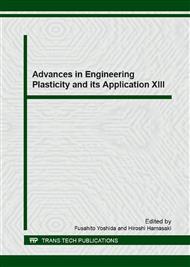[1]
M. Jackson, K. Dring, A review of advances in processing and metallurgy of titanium alloys, J Materials Science and Technology. 22(8) (2006) 881-887.
DOI: 10.1179/174328406x111147
Google Scholar
[2]
R. W Schuts, H B. Watkins, Recent developments in titanium alloy application in the energy industry, J Materials Science and Engineering A. 243 (1998) 305-315.
DOI: 10.1016/s0921-5093(97)00819-8
Google Scholar
[3]
N. Meyendorf, B. Frankenstein, L, Schubert, Structural health monitoring for aircraft, ground transportation vehicles, wind turbines and pipes-prognosis, Emerging Technologies in Non-Destructive Testing V. (2012), 15-22.
Google Scholar
[4]
E. Mendoza, J. Prohaska, C. Kempen, Y. Esterkin, S. J. Sun, In-Flight Fiber Optic Acoustic Emission Sensor (FAESense (TM) System for the Real Time Detection, Localization, and Classification of Damage in Composite Aircraft Structures. Photonic Applications for Aerospace, Commercial, and Harsh Environments Iv. 8720.
DOI: 10.1117/12.2018155
Google Scholar
[5]
Y.L. Yue, P.Y. Wei, S. H. LI; Acoustic Emission Signature of Fatigue Cracks at Titanium Alloy Welded Joints Journal of Ship Mechanics. 12(3) (2008) 429-439.
Google Scholar
[6]
S. Mindess, CRC Handbook of Nondestructive Testing of Concrete Acoustic emission methods, CRC, Boca Raton, FL (2004).
Google Scholar
[7]
Y. Seo, Y.R. Kim, Using Acoustic Emission to Monitor Fatigue Damage and Healing in Asphalt Concrete. Ksce Journal of Civil Engineering. Composites Part B. 12(7) (2008) 237-243.
DOI: 10.1007/s12205-008-0237-3
Google Scholar
[8]
J. Brown, L. Vendra, A. Rabiei, Bending properties of Al-steel and steel–steel composite metal foams. Metall Mater Trans A. 41(11) (2010) 2784–2793.
DOI: 10.1007/s11661-010-0343-y
Google Scholar
[9]
J. S. Wang, L. J. Yao, L. B. Zhang, L. D. Chen,X. Y. Tong, Acoustic Emission Analysis on Low Velocity Impact Damage of 2D C/SiC. Advanced Measurement and Test, Pts 1-3 (2011) 301-303 1367–1371.
DOI: 10.4028/www.scientific.net/amr.301-303.1367
Google Scholar
[10]
D.G. Aggelis, E.Z. Kordatos, T.E. Matikas. Acoustic emission for fatigue damage characterization in metal plates. Mechanics Research Communications. 38 (2011) 106–110.
DOI: 10.1016/j.mechrescom.2011.01.011
Google Scholar
[11]
B. H. Han, D. J Yoon, Y. H. Huh, Y. S. Lee, Damage assessment of wind turbine blade under static loading test using acoustic emission. Journal of Intelligent Material Systems and Structures. 25(5) (2014) 621–630.
DOI: 10.1177/1045389x13508329
Google Scholar
[12]
D.G. Aggelis, E.Z. Kordatos, T.E. Matikas. Acoustic emission for fatigue damage characterization in metal plates. Mech Res Commun. 38(2) (2011) 106–110.
DOI: 10.1016/j.mechrescom.2011.01.011
Google Scholar
[13]
B . Yang, P. K. Liaw, G. Wang,W. H. Peter, R. A. Buchanan, Y. Yokoyama, Thermal imaging technologies for detecting damage during high-cycle fatigue, Metall Mater Trans A. 35(A1) (2004) 15–23.
DOI: 10.1007/s11661-004-0104-x
Google Scholar
[14]
D. Wagner, N. Ranc, C. Bathias, P. C. Paris, Fatigue crack initiation detection by an infrared thermography method, Fatigue & Fracture of Engineering Materials & Structures, 33(1) (2009) 12–21.
DOI: 10.1111/j.1460-2695.2009.01410.x
Google Scholar
[15]
R. Steinberger, T.I. Valadas Leitão, E. Ladstätter, G. Pinter, W. Billinger, R.W. Lang, Infrared thermographic techniques for non-destructive damage characterization of carbon fibre reinforced polymers during tensile fatigue testing, International Journal of Fatigue. 28 (2006).
DOI: 10.1016/j.ijfatigue.2006.02.036
Google Scholar
[16]
A. Risitano, G. Risitano, Cumulative damage evaluation of steel using infrared thermography, Theor Appl Fract Mech. 54(2) (2010) 82–90.
DOI: 10.1016/j.tafmec.2010.10.002
Google Scholar
[17]
E.Z. Kordatos, D.G. Aggelis, T.E. Matikas, Monitoring mechanical damage in structural materials using complimentary NDE techniques based on thermography and acoustic emission Composites Part B. 43(6) (2012) 2676-2686.
DOI: 10.1016/j.compositesb.2011.12.013
Google Scholar
[18]
E.Z. Kordatos, K.G. Dassios, D.G. Aggelis, T.E. Matikas, Rapid evaluation of the fatigue limit in composites using infrared lock-in thermography and acoustic emission, Mechanics Research Communications. 54 (2013) 14-20.
DOI: 10.1016/j.mechrescom.2013.09.005
Google Scholar
[19]
K.G. Dassios, E.Z. Kordatos, D.G. Aggelis, T.E. Matikas, Nondestructive Damage Evaluation in Ceramic Matrix Composites for Aerospace Applications. Scientific World Journal. 2013; Information on http: /dx. doi. org/10. 1155/2013/715945.
DOI: 10.1155/2013/715945
Google Scholar


